
With the pension being insolvent, the State of NM has been passing bills modifying the pension. The Pension Plan covers state employees. The changes have effectively created three member types.
- Retirees over the age of 75 as of June 30, 2020 (28% of retirees fall into this class). Retirees are also Tier 1 Members.
- Tier 1 Members (employed before June 30, 2013)
- Tier 2 Members (employed after June 30, 2013)
The structure of the pension now resembles a Ponzi scheme. Retirees over the age of 75 are receiving the pension that was promised whereas everyone else is receiving less and contributing more. The State of NM has been mismanaging the pension for years by generous benefits and not addressing the age requirement for receiving a pension. Now the State of NM is making drastic changes to make the pension solvent to avoid having its bond rating lowered again. In 1991 Moody’s Investment Service downgraded NM’s bond rating from an AA1 to an AA2 for the pension unfunded liability.
The changes to the Pension Plan:
COLA (Cost of living Adjustment)
Table showing COLA for Retirees over the age 75 and Tier 1 Members.
Year | Retirees over 75 | Tier 1 Members |
1982 | COLA tied to the Consumer Price Index with a maximum of 3% | COLA tied to the Consumer Price Index with a maximum of 3% |
1992 | 3% COLA compounded annually | 3% COLA compounded annually |
2013 | 2% COLA compounded annually | 2% COLA compounded annually |
2020 | 2.5% COLA | 0% COLA |
2021 | 2.5% COLA | 0% COLA |
2022 | 2.5% COLA | 0% COLA |
Life of Pension | 2.5% COLA | 0.5% COLA* |
Tier 2 Members (employed after June 30, 2013)
First two years of Retirement | 0% COLA |
Third year | 0.5% COLA* |
Life of Pension | 0.5% COLA* |
* Future COLAs are based on the Funded Ratio and Investment Return. The following table is the PERA Variable COLA Payment Calculator used to calculate COLA.
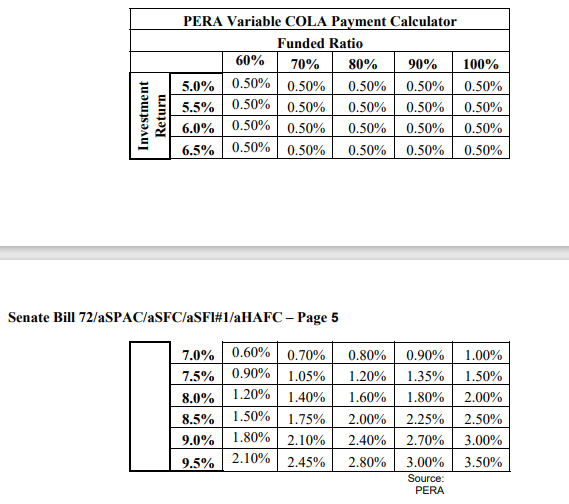
Based on PERA’s COLA Table, a Fund Ratio of 100% and an average investment return of 6.5%, the future COLA will be 0.5%. PERA’s average investment return for the last 5 years was 6.35%. For the last 3 years, the average investment return was 3.75%. With the investment return being an average return over several years, a COLA of 0.5% is a reasonable value for all future COLA.
Pension Factor and Final Average Salary
In 1995, the pension factor multiplier was increased from 2.5% to 3.0% and applied to all service credits already earned by active employees. The retroactive increase in benefits resulted in many retirees receiving an enhanced benefit for which contributions were never made, increasing the fund liability with no source of funding to cover the increase in benefits.
Tier 1 Members and Retirees over 75
The pension factor multiplier is 3.0%
The final average salary is based on 36 consecutive months.
Tier 2 Members
The pension factor multiplier is 2.5%
The final average salary is based on 60 consecutive months.
Example of how the pension factor multiplier and the final average salary are used to calculate pension:
(Years of Service Credit) X (Pension Factor) X (Final Average Salary) = Monthly Benefit
Example: for a member retiring with 25 years of service credit with a final average monthly salary of $5,333.
For Tier 1 Member and Retirees over 75:
25 | X | 3% | X | $5,333 | = | $4,000 |
(years of service credit) |
| (pension factor) |
| (final average salary) |
| (Monthly benefit) |
For Tier 2 Member:
25 | X | 2.5% | X | $5,333 | = | $3,333 |
(years of service credit) |
| (pension factor) |
| (final average salary) |
| (Monthly benefit) |
The following table shows the differences between a Pension for Retirees over 75, Tier 1 and Tier 2 Retirees. The table is based on a pension of $4,000 per month for Retiree over 75 and Tier 1. For Tier 2 Retirees, a pension of $3,333 per month.
Year | Monthly Pension Retirees over 75 | COLA (2) | Monthly Pension Tier 1 | Monthly Pension Tier 2 | COLA Tier 1 and 2 |
2019 | $4,000 |
| $4,000 | $3,333 |
|
2020 | $4,100 | 2.5% | $4,000 | $3,333 | 0% (2) |
2021 | $4,203 | 2.5% | $4,000 | $3,333 | 0% (2) |
2022 | $4,308 | 2.5% | $4,000 | $3,333 | 0% (2) |
2023 | $4,415 | 2.5% | $4,020 | $3,350 | 0.5% (1) |
. .
| . .
| . .
| .
| . .
| . . |
2048 | $8,186 | 2.5% | $4,554 | $3,794 | 0.5% (1) |
2049 | $8,390 | 2.5% | $4,554 | $3,813 | 0.5% (1) |
Total | $2,208,013 |
| $1,582,777 | $1,318,849 |
|
( 1 ) COLA is based on PERA’s Variable COLA Payment Calculator and an average investment return of 6.5%.
( 2 ) 2020 Senate Bill 72 Retirees over 75 received a COLA of 2.5% for life, everyone else received a 0% COLA for years 2020, 2021 and 2022.
After 30 years, the monthly pension for Tier 2 Members is $3,813 which is less than half the pension of $8390 for Retiree over 75. Tier 1 Members pension is $4,554.
Retirement Age Requirement:
Tier 1 Members and Retirees over 75
25 years of service could retire at any age.
Tier 2 Member
Any age if the sum of the member’s age and years of credited service equal at least 85 (Rule of 85 for retirement). For a member with 25 years of service would have to be age 60 to retire (25 years of service + age 60 = 85)
Social Security and other State Pension specify a minimum age for starting to receive a pension. In 2013 Senate Bill 27 finally addressed the minimum age, but it only applies to Tier 2 Members (employees hired after June 30, 2013). This problem was discussed 30 years ago, and nothing was done until now. An article in the Albuquerque Journal dated December 13, 1994, titled: “Out of Control Annuity System” addresses the problem with the pension:
There is no age requirement for receiving a pension, so an individual who begins working for the state at age 18 could retire at age 43 with a pension worth 75% of his or her final salary. (Many state workers do retire in their 40s.) After three years, an automatic cost-of-living adjustment (COLA) of 3% kicks in and is added each year to the base pension.
Since a 43 year old has a life expectancy of 40 years, the state will in all probability end up paying the young retiree a pension for a much longer period than the individual actually worked. A state worker with a final average earning of, say, $32,000 would receive an initial pension of $24,000. With an annual COLA benefit added, the retiree will receive a pension of $71,645 a year. 40 years later. This amount is close to $2 million for young retirees, with an average life expectancy.
Employee Pension Contribution
Tier 1 and 2 Members
In 2020, Senate Bill 72 increased employer and employee contributions by 0.5 percent per year for four years resulting in a 2% increase in both contribution rates. The employee pension contribution went from 8.92% to 10.92%. Consequently, employees will experience a 2% reduction in their pay due to the increased pension contribution rate.
House Bill 106 – 2023 Legislation Session
In the 2023 legislative session, House Bill 106 was enacted, raising the maximum pension benefit from 90% to 100% of the final average salary. The rationale behind this adjustment is to incentivize workers to prolong their careers. Funding for the Bill was not provided so it will reduce the Pension solvency.
Years of Service Required for Maximum Pension Benefit
(State General Coverage Plan 3)
Tier 1 | Tier 2 | ||
90% (Current) | 100% (HB 106) | 90% (Current) | 100% (HB 106) |
30 | 33.3 | 36 | 40 |
Summary:
The NM State’s attempt to make its Pension Fund solvent is not fair for all participants. Workers forgo higher wages in exchange for a promise of a future payment secured by trust property. The trust is supposed to be used to pay the same pension to all the beneficiaries. However, the State of New Mexico has created different classes of members, treating each class differently. The oldest retirees receive the best benefits, while current employees have to pay more into the pension and receive the least benefits.
This raises concerns about fairness and the equitable distribution of pension benefits, as the State has created different classes of members and is treating them unequally. It seems the State of New Mexico is modeling its pension reforms after a Ponzi scheme.
Under ERISA (Employee Retirement Income Security Act), the State of NM has fiduciary responsibilities. One of the fiduciary responsibilities is to not give preferential treatment to beneficiaries within a particular class of members or otherwise favor one class over the others. Effective trustees must balance the interests of all member types, ensuring fair treatment for each class. However, ERISA does not govern government pensions. The State of New Mexico is not following ERISA rules.
The changes to the pension are legal under New Mexico state law. A pension does not attain the status of personal property until the individual begins receiving retirement benefits. Therefore, the State can make changes to the pension without concern for the 5th Amendment of the U.S. Constitution, which requires compensation for any property taken away.
The changes to the Cost-of-Living Adjustment (COLA) are also legal under NM state law. In 2013, the NM State Supreme Court ruled that any future COLA to a retirement benefit is merely a year-to-year expectation that, until paid, does not create a property right under the State Constitution. Once paid, the COLA by statute becomes part of the retirement benefit and a property right subject to those constitutional protections.
Not being happy with the changes to the pension, I have created this website showing the changes made to the pension which now resembles a Ponzi scheme. I have also created some cartoons making fun of the pension changes. Please share this on your social media platforms to enhance the website’s visibility in search engines, so others can learn about the changes to the pension plan.

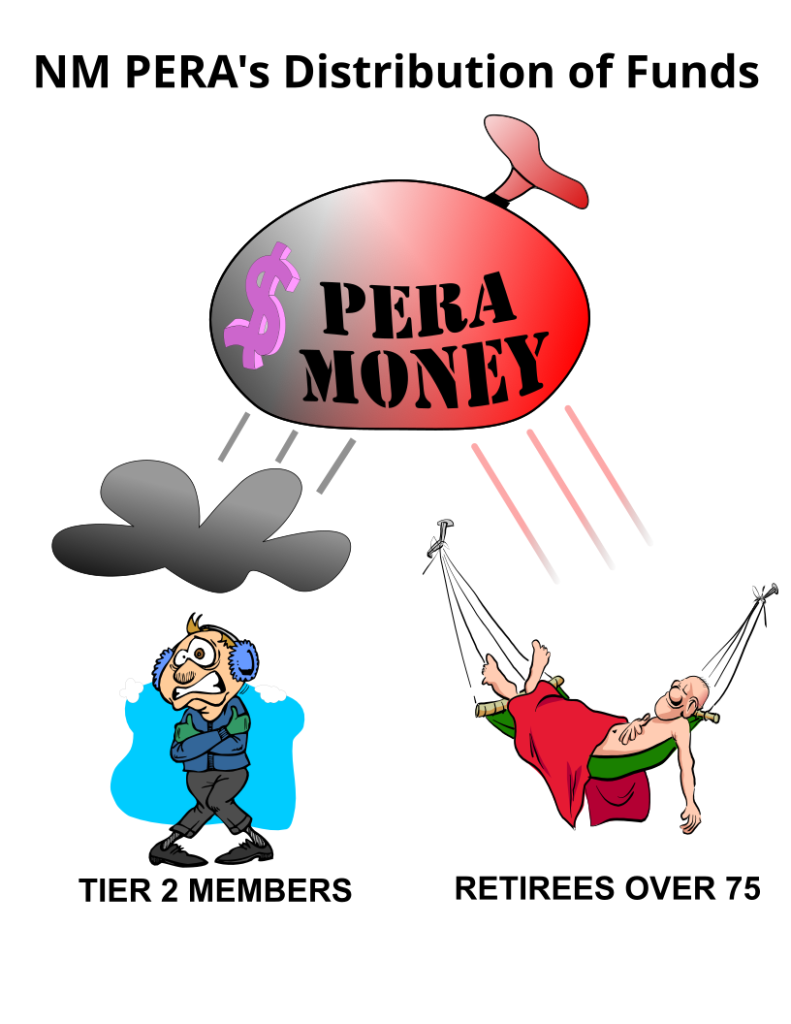
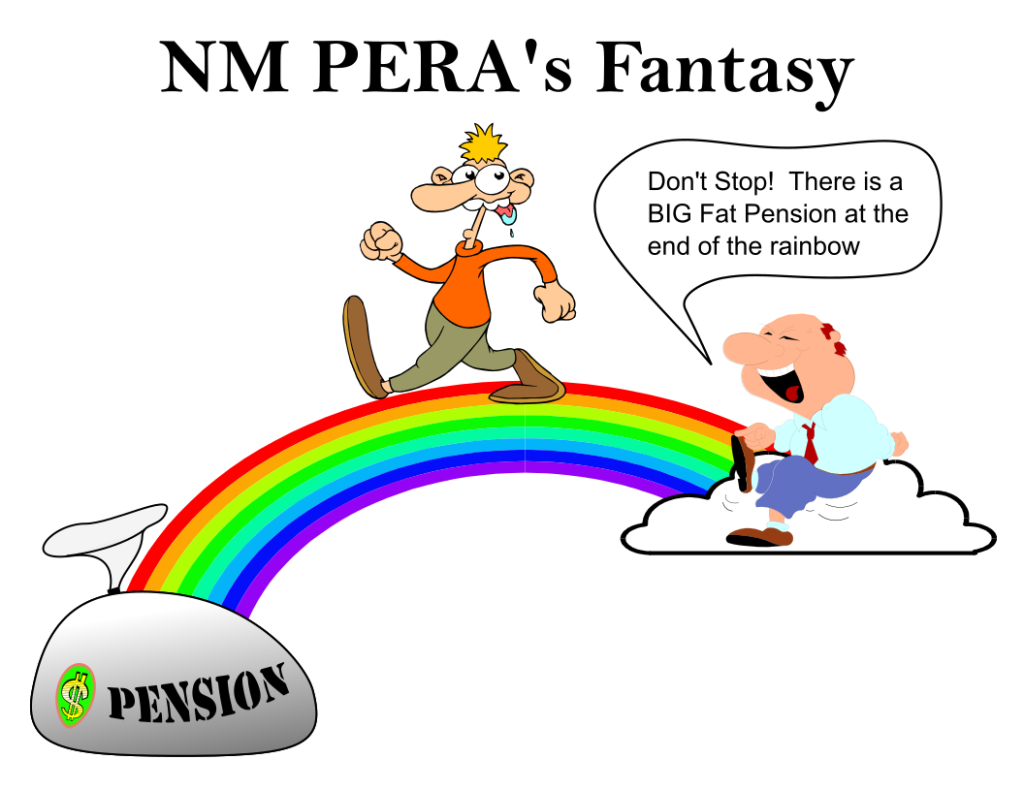
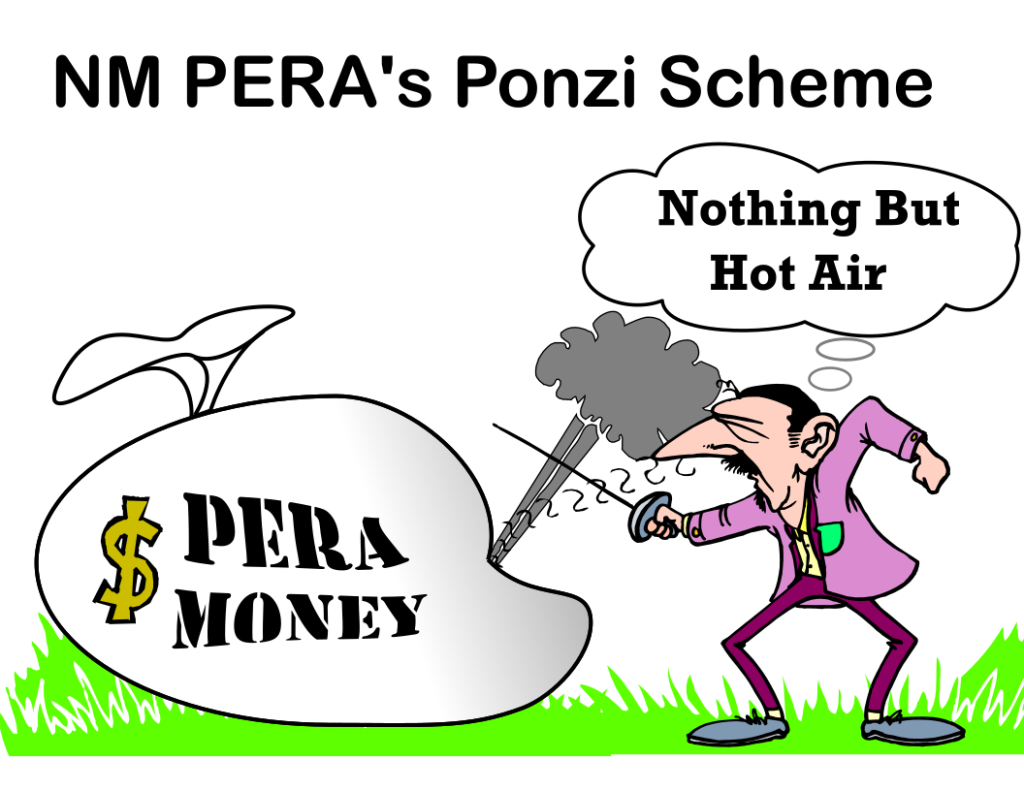
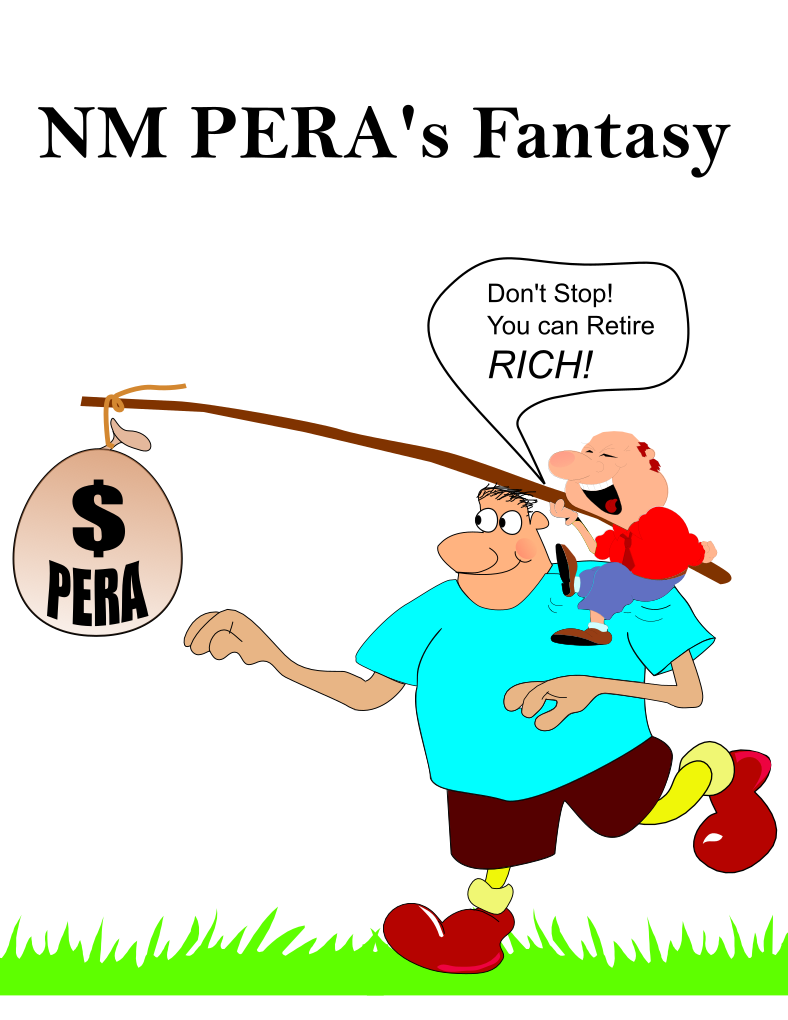
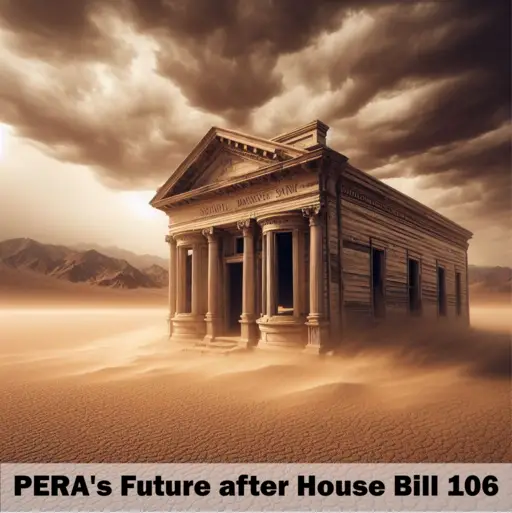

If you’re unhappy with your NM PERA pension, please share your concerns on social media. This can boost the website’s visibility in search engines, helping others learn about the pension plan changes. Let’s make this information go viral to push the State of NM to implement fairer pension reforms.
I do not see any simple solution to make PERA solvent, but the State of NM needs to create two separate pensions: one for Tier 1 Members and one for Tier 2 Members. It is unconscionable to have Tier 2 Members responsible for the pension solvency by reducing their benefits and increasing the required payroll pension deduction from 8.92% to 10.92%.
The State of NM also needs to reduce the COLA for retirees over 75 (as of June 30, 2020) to 0% until their pension payout is the same as the rest of the Tier 1 retirees.
Feel free to leave comments about the pension changes or suggestions for improving the website. If you would like to contact me directly, the email address is zann@nmponzi.com.
keywordsYou can get more keyword targeted traffic to your website from Google without paying for each click and PPC bidding competition?
With our keyword targeted banner technology you can achieve top position in search engine results in less than 24 hours and get guaranteed monthly visitors to your website.
You will save months of waiting for SEO and thousands of dollars on PPC Bidding competition.
If you are interested, just let me know. Also, send me list of your keywords and I’ll send you minimum traffic guarantee on each of them.
I just explored your site and had a few questions. Is this the correct contact method?
Response from Ponzi scheme
Sorry about the slow response. The WordPress software was supposed to email me when anything was posted to the website. I never received the email.
I have set up an email that you can contact me directly. The email is zann@nmponzi.com.
Hi Zann! This is really informative. I think all the information is presented pretty clearly. On your Ponzi Scheme page, I suggest adding the year of Senate Bill 72 (until I read the Pension Changes page, I thought it was a typo from the aforementioned Senta Bill 27). It would be helpful to me to have a definition of the “funding ratio” in the Variable COLA factor table. I think you could stress the fact that PERA’s average return on investment is below the threshold of activating the variable COLA. Although PERA’s poor investment performance is a somewhat separate issue from the “fairness” claim you are presenting. The retirees over 75 making the big bucks, is that people at age 75 now in 2024?
I’m left wondering if you have any suggestions for solutions- reduce the COLA for people age 75 to match that of all other Tier 1 members? Any ideas on what PERA needs to do to make it fair for all members? Consider adding a third page of suggested actions for PERA, whether it be your ideas or action items for them to investigate. Give them some homework assignments!
Response from Ponzi scheme
Thanks for your comments. I have made the changes to the website. I have also included information on House Bill 106 from the 2023 Legislation Session. House Bill 106 raised the maximum pension benefit from 90% to 100% of the retiree’s final average salary.
When politicians still feel they can use PERA as their personal piggy bank for personal gains, I do not anticipate the governor or legislators to come up with a solution for a more fair and equitable distribution of pension benefits unless PERA members force the issue. That is what I am hoping the website will do.
The Retirees receiving the extra benefits have to be age 75 as of June 30, 2020 (28% of retirees fall into this class)